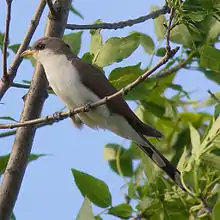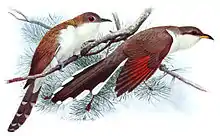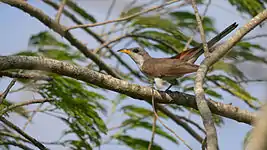Yellow-billed cuckoo
The yellow-billed cuckoo (Coccyzus americanus) is a cuckoo. Common folk-names for this bird in the southern United States are rain crow and storm crow. These likely refer to the bird's habit of calling on hot days, often presaging rain or thunderstorms.
| Yellow-billed cuckoo | |
|---|---|
 | |
| Scientific classification | |
| Kingdom: | Animalia |
| Phylum: | Chordata |
| Class: | Aves |
| Order: | Cuculiformes |
| Family: | Cuculidae |
| Genus: | Coccyzus |
| Species: | C. americanus |
| Binomial name | |
| Coccyzus americanus | |
 | |
| Synonyms | |
|
Cuculus americanus Linnaeus, 1758 | |
The genus name is from Ancient Greek kokkuzo, which means to call like a common cuckoo, and americana means "of America".[2]
Description

Adults have a long tail, brown above and black-and-white below, and a black curved bill with yellow especially on the lower mandible. The head and upper parts are brown and the underparts are white. There is a yellow ring around the eye. It shows cinnamon on the wings in flight. Juveniles are similar, but the black on the undertail is replaced by gray.
Measurements:[3]
- Length: 10.2-11.8 in (26-30 cm)
- Weight: 1.9-2.3 oz (55-65 g)
- Wingspan: 15.0-16.9 in (38-43 cm)
Taxonomy and conservation
There is an ongoing debate regarding the taxonomic status of the western race and if it is distinct from those birds in the east. This question is significant to the conservation status of this species in the west, where it has declined to a tiny fraction of its population a century ago.[4][5][6] Populations of this species in western North America are in steep decline. The bird disappeared from British Columbia, Washington, and Oregon during the first half of the twentieth century. Eastern populations have declined as well, though not as precipitously. The United States Fish and Wildlife Service listed the western Distinct Population Segment (DPS) of Yellow-billed Cuckoos as threatened under the Endangered Species Act on 11/3/2014,[7] and the service also has established 546,335 acres in nine western states as critical habitat for the western DPS of the yellow-billed cuckoo.[8][9] Controversy over the taxonomic status and heavy pressure from livestock and mining industries caused the Trump administration to attempt to end the species' protections, and the FWS reviewed the bird's listing.[10] In September 2020, the USFWS determined that the western DPS of yellow-billed cuckoo is distinct, and the listing as Threatened is warranted.[11]
Habitat and range
Their breeding habitat is deciduous woods from southern Canada to Mexico and the Caribbean. They migrate to Central America, and as far south as northern Argentina. This bird is a rare vagrant to western Europe.
Diet
These birds forage in dense shrubs and trees, also may catch insects in flight. They mainly eat insects, especially tent caterpillars and cicadas, but also some lizards, eggs of other birds and berries. Cuckoos sometimes congregate near insect outbreaks or emergences, including outbreaks of exotic gypsy moth caterpillars.[12]
Breeding
They nest in a tree or shrub, usually up to 2–12 feet (1–4 meters) above the ground. The nest is a flimsy platform of short twigs placed on a horizontal branch. The 3-4 eggs are incubated for 14 days or less. The chicks are able to climb about with agility at 7–9 days of age. At about this same time, the feathers of the chicks burst out of their sheaths and the young are able to fly. The entire time from egg-laying to fledging may be as little as 17 days. Yellow-billed cuckoos occasionally lay eggs in the nests of other birds (most often the closely related black-billed cuckoo), but they are not obligate brood parasites of other birds as is the common cuckoo of Eurasia.
Images
 Yellow-billed cuckoo
Yellow-billed cuckoo Yellow-billed cuckoo
Yellow-billed cuckoo
References
- BirdLife International (2012). "Coccyzus americanus". IUCN Red List of Threatened Species. 2012. Retrieved 26 November 2013.CS1 maint: ref=harv (link)
- Jobling, James A (2010). The Helm Dictionary of Scientific Bird Names. London: Christopher Helm. pp. 44, 112. ISBN 978-1-4081-2501-4.
- "Yellow-billed Cuckoo Identification, All About Birds, Cornell Lab of Ornithology". www.allaboutbirds.org. Retrieved 26 September 2020.
- Yellow-Billed Cuckoo Species Account, Sacramento Fish & Wildlife Office
- Biogeography of Western Yellow Billed Cuckoo
- Fleischer, Robert C. "Taxonomic and Evolutionarily Significant Unit (ESU) Status of Western Yellow-billed Cuckoos (Coccyzus americanus)". Report to the USGS and USFWS.
- https://ecos.fws.gov/ecp/species/3911#crithab
- https://www.govinfo.gov/content/pkg/FR-2020-02-27/pdf/2020-02642.pdf#page=1
- "Endangered and Threatened Wildlife and Plants; Designation of Critical Habitat for the Western Distinct Population Segment of the Yellow-Billed Cuckoo (Coccyzus americanus)". Federal Register. 2 December 2014. Retrieved 29 June 2018.
- "Trump Administration Moves to Strip Endangered Species Protections From Threatened Western Songbird". www.biologicaldiversity.org. Retrieved 29 June 2018.
- https://ecos.fws.gov/docs/five_year_review/doc6613.pdf
- Barber, NA; Marquis, RJ; Tori, WP (2008). "Invasive prey impacts the abundance and distribution of native predators". Ecology. 89 (10): 2678–2683. doi:10.1890/08-0395.1. PMID 18959305.
Further reading
- John K. Terres (1980), Audubon Society Encyclopedia of North American Birds, Knopf, ISBN 0-394-46651-9
- David Gaines Review of the Status of the Yellow-Billed Cuckoo in California: Sacramento Valley Populations The Condor, Vol. 76, No. 2 (Summer, 1974), pp. 204–209
- Laymon, S.A., and M.D. Halterman. 1987. Can the western subspecies of Yellow-billed Cuckoo be saved from extinction? Western Birds 18:19-25.
External links
| Wikimedia Commons has media related to Coccyzus americanus. |
